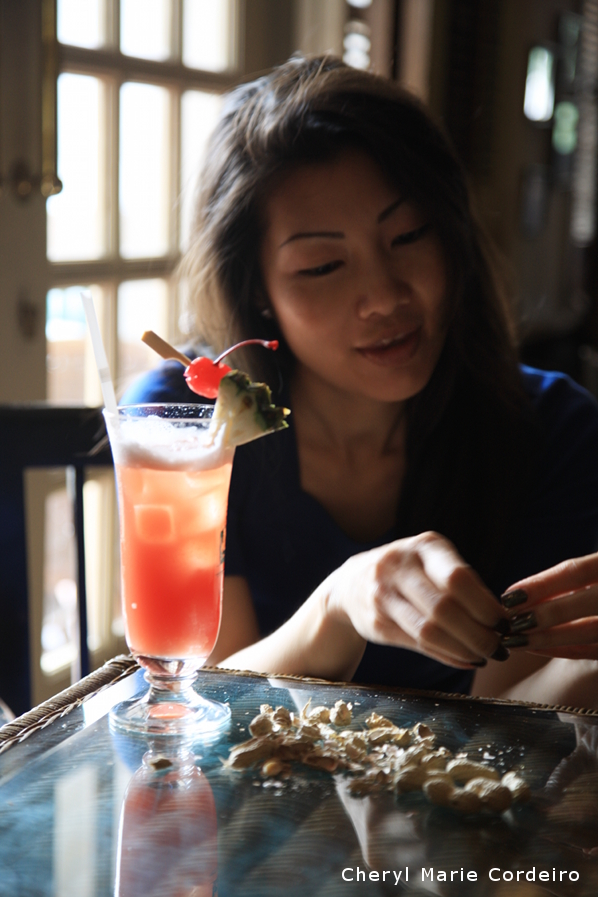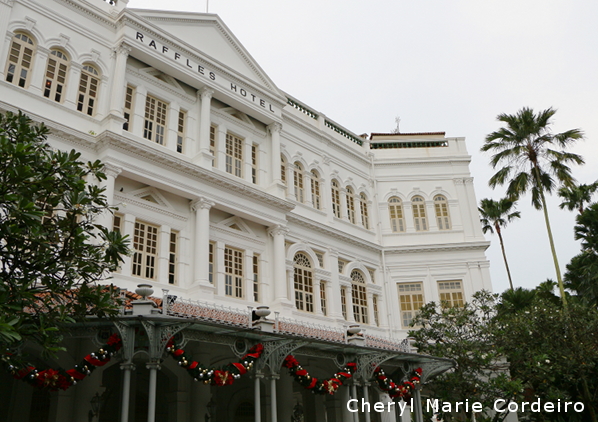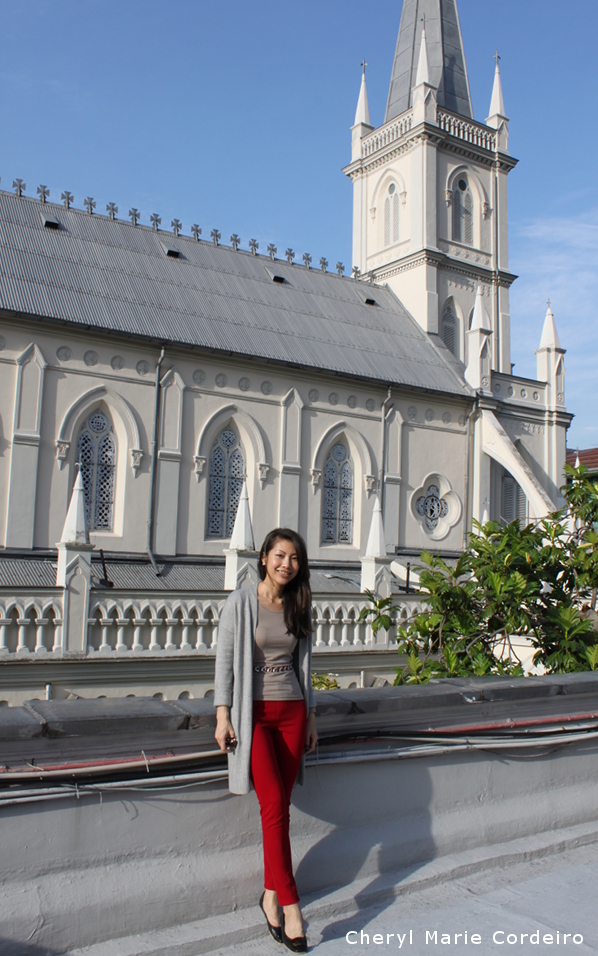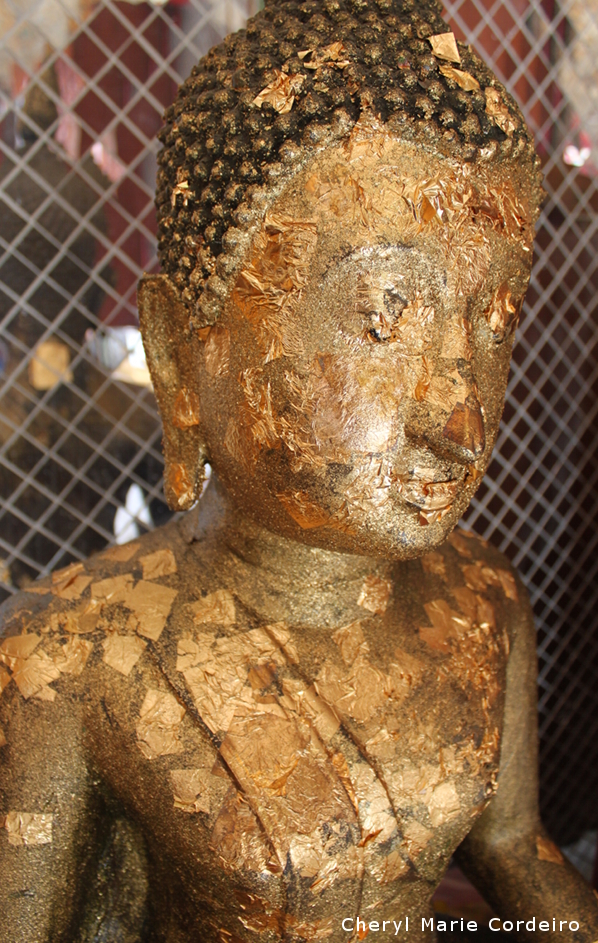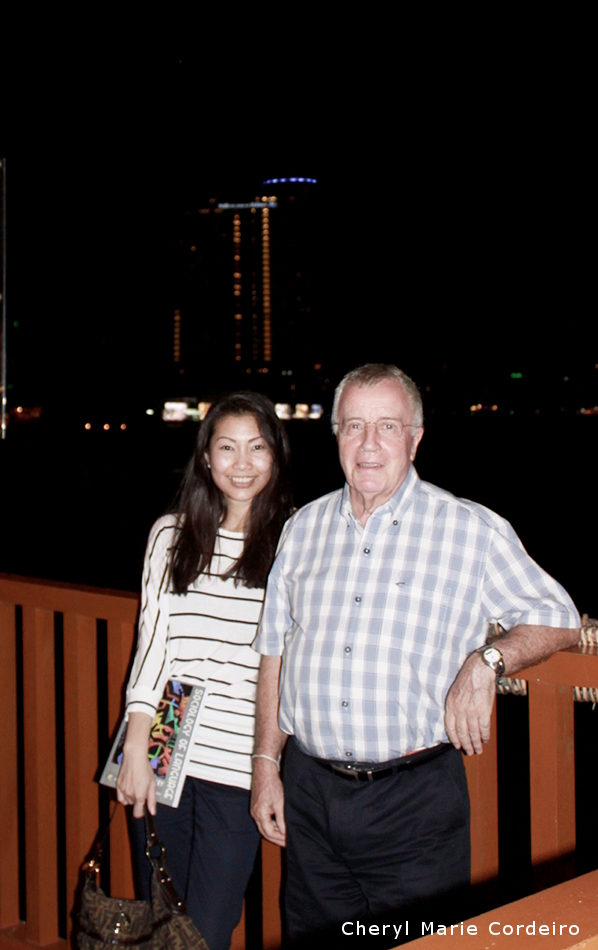Touching base with our favourite watering hole.
Singapore Sling, Long Bar, Raffles Hotel, Singapore.
Text & Photo © JE Nilsson, CM Cordeiro 2013
Rooftop at CHIJMES
Rooftop in the morning, at CHIJMES
Text & Photo © K Leong, JE Nilsson, CM Cordeiro 2013
The CHIJMES cluster of buildings along Victoria Street is what to me remains as one of the more beautiful architectural features in the changing landscape of modern Singapore.
Having grown up in another Convent of the Holy Infant Jesus (CHIJ), I feel right at home strolling the grounds of this one in the heart of the city. From the rooftop, you’ll get a good overview of the courtyard and the corridors of adjacent buildings that lead to once classrooms, today turned into office spaces.
The Chapel’s gothic architecture is breathtaking when basked in the morning light, in the quiet hours just prior to the rush of the city’s daily traffic.
Geely Headquarters and Cixi Plant, Hangzhou
In China’s First Automobile Health and Development Summit held in Beijing in 2012, Geely’s Emgrand EC8 was nominated one of the Top 10 environmental friendly cars for 2012. (Globaltimes.cn April 2013).
From left to right Swati Ravi, Emily Xu, Cheryl Marie Cordeiro and Joyce Wu, PR Manager of Geely.
Text & Photo © JE Nilsson, CM Cordeiro 2013
Geely HQ and Cixi Assembly plant
Friday the 15th of November was the fifth day of our visit to Shanghai in 2013. We had focused quite some on the Chinese automobile industry and today it was time to meet with Geely. Both the Geely Cixi Assembly plant and the Geely Headquarters are located in Hangzhou, Zhejiang province, a few hours drive inland, from Shanghai.
Continue reading “Geely Headquarters and Cixi Plant, Hangzhou”
Lost Heaven, the Bund, Shanghai
Creative fruit platters.
Lost Heaven, the Bund, Shanghai.
Text & Photo © C Nestor, JE Nilsson, CM Cordeiro 2013
A seduction of the senses at first step through its doors. Deep ruby red against black lacquered wooden furniture, plush table settings and good Yunnan food. Outside, around the corner in a short stroll, the beautiful lights of The Bund after sunset. It is little wonder as to what elements make Lost Heaven an appealing dining venue for that just perfect romantic Shanghai night out.
Good thing, the place, has an address. Continue reading “Lost Heaven, the Bund, Shanghai”
Visiting Volvo Group R&D, Shanghai
Visiting Volvo Group, Trucks Technology, Advanced Technology and Research, Shanghai, China.
Text & Photo © JE Nilsson, CM Cordeiro 2013
On the second day of our visit in Shanghai, we had the pleasure of meeting with the Director of Advanced Technology & Research at the Volvo Group Headquarter in Shanghai. If it is confusing for a Swede to keep track of the difference between Volvo Cars (owned by the Chinese Geely Holding Group) and Volvo AB, very much still a Swedish company, it is even worse for the Chinese, where a representative from Volvo Group Shanghai told that she often got questions from relatives if she could help them buy a Volvo car on staff discount.
Today’s meeting was with the Volvo Group.
Continue reading “Visiting Volvo Group R&D, Shanghai”
The Nordic Centre at Fudan University, Shanghai
The combined delegation of Management and Organisation,
and the Centre for International Business Studies (CIBS) of the School of Business, Economics and Law, University of Gothenburg, at the Nordic Centre, Fudan University, Shanghai.
Text & Photo © JE Nilsson, CM Cordeiro 2013
It was a brief early morning walk from the Crowne Plaza Hotel to the Nordic Centre, located in the Handan campus of Fudan University, one of China’s top ranked universities.
Continue reading “The Nordic Centre at Fudan University, Shanghai”
Sasha’s Shanghai

Voted one of Shanghai’s best restaurant and bar,
Sasha’s is situated in the romantic former French Concession area of Shanghai.
Text & Photo © JE Nilsson, CM Cordeiro 2013
North of the Bund, Shanghai
Crowne Plaza Shanghai Fudan Hotel
Text & Photo © JE Nilsson, CM Cordeiro 2013
When looking at the facade of the Crowne Plaza Shanghai Fudan Hotel it is difficult to not read into the facets of its facade some influences from the constructivist art movement that grew out of Russian Futurism in the early years of the 20th century.
Constructivist architecture flourished in the Soviet Union in the 1920s and early 1930s. Its ideas were revolutionary at the time and combined advanced technology and engineering with social purposes.
This era was also a formative one for Shanghai, as it acted as an eastern melting pot between East and West in the Warlord epoque of China in the 1910s, around the years of the Russian revolution and the financial boom of WWI. As such one would not be too surprised to find traces of these ideas right here in the Yangpu district of Shanghai where much of China’s academia flourishes today.
It is even difficult not to draw references to Russian industrialism and earlier, the cubism of Picasso and Braque, in the facets of the facade looking like human beings standing on top of, lifting, carrying and supporting each other. Architecture depicting the human strive to higher and higher achievements.
The Russian bicyclist painting by Natalia Goncharova (Cyclist, 1913) comes to mind as another reference to the Russian futurism of the 1910’s. This can be seen in contrast to the slightly older painting by Ramon Casas, of himself and Pere Romeu on a Tandem, 1897. The two works of art illustrate a dramatic change in ideologies and thus realities, that had come by in a mere few decades. The latter was painted specifically for the interior of the Els Quatre Gats in Barcelona, a restaurant and bar that was pretty much the center of the early Modernisme art movement in Barcelona at the turn of the century, and also the very place where Picasso had his first exhibition.
Continue reading “North of the Bund, Shanghai”
A Buddhistic view of markets – ‘there is no train …’ – at Maeklong, Bangkok, Thailand
Covered in gold leaves
Text & Photo © JE Nilsson, R Cordeiro, CM Cordeiro 2013
Temple visits
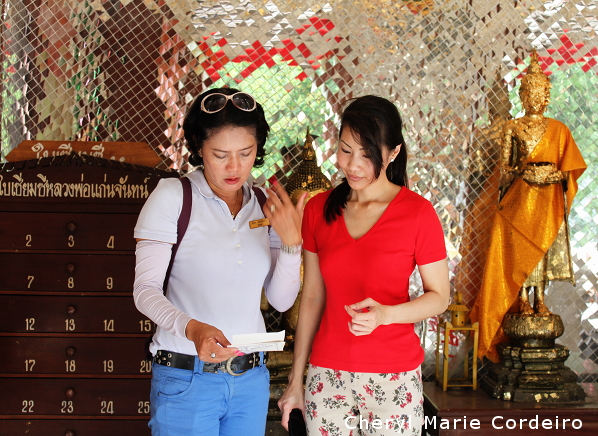
Fortune on a stick
When in Thailand on a short visit you have an endless number of options on how to spend your time. However, if you are not shopping, sunbathing, eating, drinking, boating or trying out any of the local spas or various massage options, you will eventually find that you are on your way into one or several temples.
For example, right next to the Maeklong Railway Market you will find the Wat Baan Laem temple with its important Buddha statue and just near that, another temple, and near that, another.
In one of these, I found the option of having my future read to me through a brush pot of fortune sticks. For those who have not done this, you shake a brush pot filled with numbered bamboo sticks until one of them somehow volunteers itself out of the holder. Eventually I got my stick and with the help of my guide Susie, I found the matching fortune explanation.
Continue reading “A Buddhistic view of markets – ‘there is no train …’ – at Maeklong, Bangkok, Thailand”
Meeting by the Chao Phraya, Bangkok
Cheryl Cordeiro and Professor Joe A. Foley, standing at the bank of the Chao Phraya River, Shangri-La, Bangkok, Thailand.
Text & Photo © JE Nilsson, CM Cordeiro 2013
It had been quite some years, since 2007 thereabouts, that I last visited Bangkok. The early morning drive through the city from the airport lent an immediate update of impression of just how much and how fast the landscape was changing that left me wondering if I could, with some effort, find my favourite street hawkers at the places where I once knew where they stood.
I have thus far remembered my visits to Bangkok fondly, often in the sense that I’ve managed to acquire a curiosity of items that range from floor mats, cushions to kitchen utensils and a spattering of orphaned treasures.
While the city is ever modernising, I was happy to find, what to me was its signature rhythm of a heartbeat – its wet and soggy market streets – still around the corner from where I stayed.
More than street marketing this time around was the fact that I had the pleasant opportunity to meet again with a mentor, Professor Joseph A. Foley. Joe was previously my thesis writing supervisor through all my theses, beginning with my honours and master thesis writing back at the National University of Singapore, through to my doctoral thesis writing at the University of Gothenburg. He currently lectures at the Graduate School of English at the Assumption University in Bangkok, Thailand.
We met alongside the Chao Phraya River for dinner.
Continue reading “Meeting by the Chao Phraya, Bangkok”
